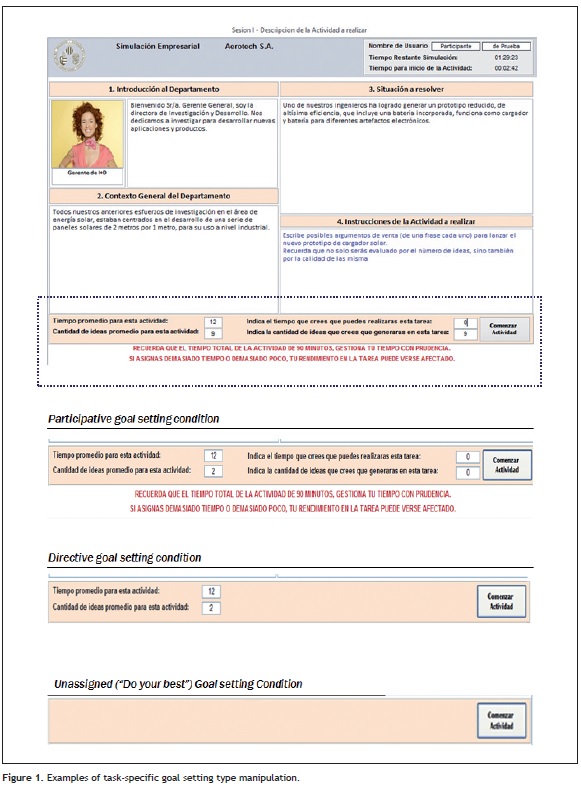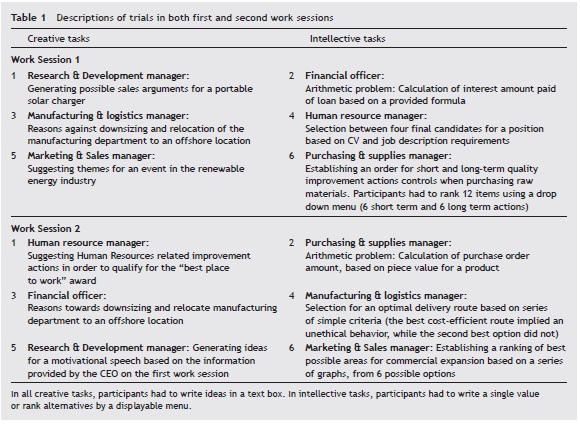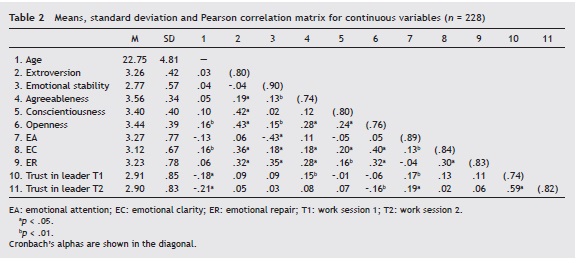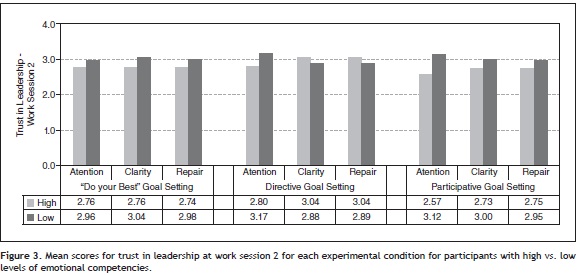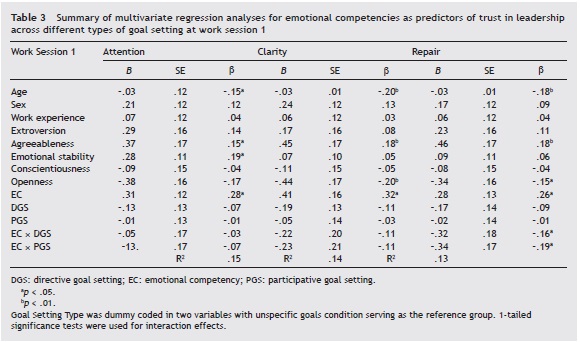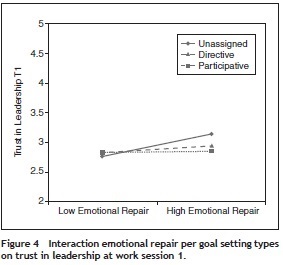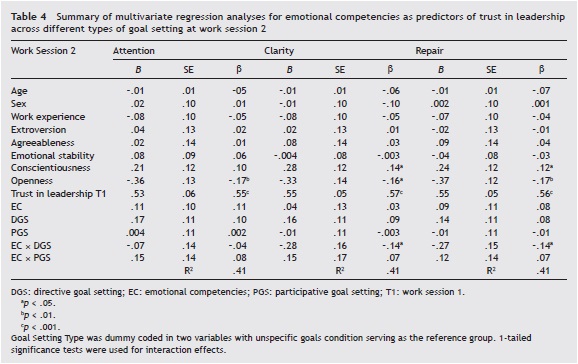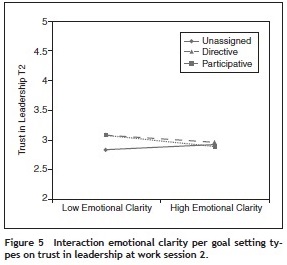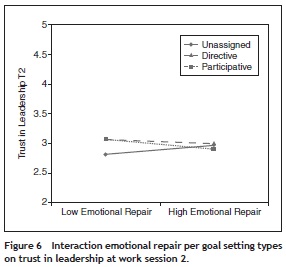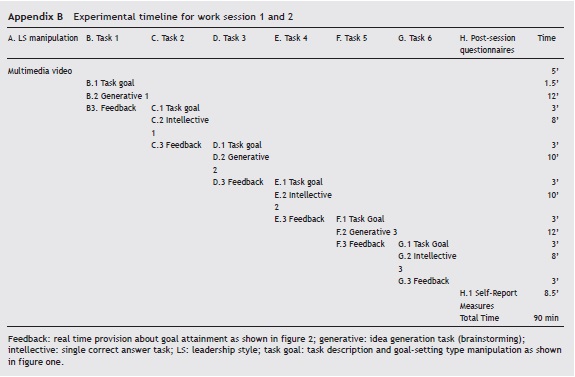Services on Demand
Journal
Article
Indicators
-
 Cited by SciELO
Cited by SciELO -
 Access statistics
Access statistics
Related links
-
 Cited by Google
Cited by Google -
 Similars in
SciELO
Similars in
SciELO -
 Similars in Google
Similars in Google
Share
Revista Latinoamericana de Psicología
Print version ISSN 0120-0534
rev.latinoam.psicol. vol.47 no.1 Bogotá Jan./Apr. 2015
Winning the hearts and minds of followers: The interactive effects of followers' emotional competencies
and goal setting types on trust in leadership*
Ganando la mente y el corazón de los seguidores: El efecto interactivo de las competencias emocionales de los seguidores y el tipo de establecimiento de metas sobre la confianza en el líder
Lucas Monzania,* Pilar Ripolla and José María Peirób
a IDOCAL, University of Valencia, Spain
b IDOCAL and IVIE, University of Valencia, Spain
*Correspondence author.
E-mail address: Jose.M.Peiro@uv.es (J.M. Peiró).
*Premio al mejor artículo del número.
Received 31 October 2013; accepted 18 July 2014
Abstract
Followers' trust is essential for effective leadership. While initial approaches to trust focused on trust-related information, recent findings suggest that trust also has an affective component. Therefore, emotional competencies such as emotional attention, clarification and repair could predict trust in leadership, in early stages of the follower-leader relation. However, as this relation develops in time, trust-related judgments may shift from followers' emotions towards leaders' behaviors such as goal setting practices. As goals can be set in either a directive or participative way, followers with different levels of emotional competences should have distinct emotional responses towards these goal-setting types. On this rationale, we evaluated a possible interactive effect between goal setting types and emotional competencies on followers' trust in leadership. For this, we conducted a two-wave experiment, randomly assigning 228 participants to two possible experimental conditions (directive vs. participative goal setting) or a control group (unspecific "Do your best" goals). We used multivariate regression analyses to test our hypotheses, controlling for demographic factors (participants age, biological gender and previous work experience) and stable personality traits. While there were no differences in trust in leadership across experimental conditions, followers' emotional competencies at work session 1 had positive main effects on followers' trust in leadership. At work session 2, significant interaction effects between directive goal setting type and both emotional clarity and repair indicate that only setting goals in a directive way will compensate low levels of followers' emotional clarity and repair.
Keywords: Emotional competencies; Goal setting types; Two-wave experiment; Trust in leadership.
Resumen
La confianza de los seguidores es un elemento esencial de un liderazgo eficaz. Las aproximaciones tempranas a la formación de la confianza hacia los líderes, adoptaron un enfoque basado en evaluaciones basadas en información. Sin embargo, avances recientes en la investigación de la confianza sugiere que estas evaluaciones también contienen un componente afectivo. En este estudio proponemos que las competencias emocionales, como (1) atención, (2) claridad y (3) reparación emocional predecirán la confianza hacia el líder en momentos tempranos de la relación líder-seguidor. A medida que esta relación se desarrolla en el tiempo, las evaluaciones sobre la fiabilidad del líder cambiaran su objetivo, más precisamente de las emociones que el líder despierta a la manera en que este establece las metas. Debido a que las metas pueden ser establecidas de manera directiva o participativa, los seguidores con diferentes niveles en estas tres competencias emocionales, deberían presentar diferentes respuestas emocionales hacia dichas prácticas de establecimiento de metas. Basándonos en esta idea, evaluamos un posible efecto interactivo de las competencias emocionales y el tipo de establecimiento de metas sobre los puntajes de confianza hacia el líder de los seguidores. Para esto, realizamos un experimento longitudinal de dos sesiones de trabajo al cual asistieron 228 participantes. Las competencias emocionales de los seguidores en la primera sesión de trabajo tuvieron un efecto positivo sobre su confianza en el líder, mientras que se detectó un efecto de interacción entre la reparación emocional y el tipo de establecimiento de metas. En la segunda sesión de trabajo, solo se detectaron efectos de interacción entre la claridad y la reparación emocional y el establecimiento de metas directivo. Este resultado indica que el hecho de establecer metas, y no como estas se establecen es lo que compensara el efecto negativo sobre la confianza en el líder de bajos niveles de claridad y reparación emocional de los seguidores.
Palabras clave: Competencias emocionales; Tipos de establecimiento de metas; Experimento longitudinal; Confianza en el líder.
The idea that developing mutual trust-based relationships between leaders and followers is critical for effective leadership has become a commonplace in leadership research (Brower, Schoorman & Tan, 2000). Followers' trust is what sustains a leader's real authority, yet some leaders seem not to understand what a precious gift a trusting follower is (Mishra & Mishra, 2013). Thus, watered by the economic and social collapse of 2008-2009, the poisonous seed of distrust has flourished. For example, after decades of abusing their followers' confidence, leaders of political parties now face daily demonstrations of people who are literally shouting in their faces that they have lost the faith in those whom they chose to "run the show". On the other hand, emerging corporate scandals such as insider trading followed by massive layoffs, have ripped the fabric of an already weak psychological contract between employees and managers. As a result, negative emotions such as fear, anger and anxiety run wild, and trust has become a scarce resource in both public and private sectors.
In this adverse context, politicians and managers who are still willing to do the right thing, face the challenge of wining the trust of an increasingly number of skeptic followers. We believe that in order to build trust in their leadership, they should first have a greater understanding of what psychosocial factors are involved in winning the "hearts and minds" of their followers.
Probably the first barrier for developing trust in leadership is a lack of clear consensus about trust formation. Recent empirical research is changing our understanding of this construct, as new elements such as emotions and temporal dynamics have entered the trust formation equation.
Initial models of trust formation adopted an information perspective. These models suggested that people use different sources of information to judge whether or not someone is trustworthy (Mayer, Davis & Schoorman, 1995). For example, behaviors such as setting clear and compelling goals can be cues to followers about their leader's ability to lead them into performing a task successfully (Burke, Sims, Lazzara & Salas, 2007). Yet, while researchers found a positive relation between goal setting and work attitudes such as commitment (Klein, Cooper & Monahan, 2013; Locke & Latham, 1990), up to now, how goals and goals setting types affect followers' trust in leadership has not received much attention in academic research (a noteworthy exception is Crossley, Cooper & Wernsing, 2013).
On the other hand, recent findings suggest that trust formation has an affective component (Lu, 2014; Newman, Kiazad, Miao & Cooper, 2013). Followers see not only information process cues, but also attend to the emotions that arise before or during exchanges with their leader for making these judgments. Some scholars have stressed the importance of further exploring linkages between emotions and trust (Schoorman, Mayer & Davis, 2007; Williams, 2001). For example talking about trust in leadership, Gooty, Connelly, Griffith and Gupta (2010) stated: "While much has been done in the domain of cognitive influences on trust in leadership, much less research attention has focused upon affective influences in trusting one's leader" (p. 1000)." Because some individuals are highly competent in perceiving, understanding and regulating their emotions (Mayer, Roberts & Barsade, 2008), exploring whether emotional competencies could influence their judgments about a leader's trustworthiness could further expand our knowledge of the dynamics of trust formation.
After an extensive review of the trust literature, Martínez-Tur and Peiró (2009) suggest that timing plays an important role in trust formation. In their model, two or more parties mutually shape trust in specific episodes. In these episodes, both parties establish a relational exchange process, where proximal and distal antecedents of trust interact with the environment affecting trust formation and maintenance. These authors make a call for better understanding the interactive nature of individual, situational and temporal factors in the emergence and maintenance of trust.
In this paper, we seek to clarify the dynamics involved in the formation of followers' trust in leadership. To this end, within a controlled environment, we explored the effect of followers' emotional competencies (EC) such as emotional attention, clarity and repair on trust in leadership, at different episodes of a leader-follower relation. In addition, we tested if informational cues, such as leader's goal setting type, interact with followers ECs in later trust episodes.
Understanding the nature of trust and the dynamics of its formation is important to management because meta-analytic findings show that trust predicts citizenship behaviors, task performance, risk taking behaviors and counterproductive behaviors (Colquitt, Scott & LePine, 2007). Previous research defined trust either as a personality trait (e.g. propensity to trust; Rotter, 1967), a process (Khodyakov, 2007), an emerging state (Jarvenpaa & Leidner, 1999; Jarvenpaa, Shaw & Staples, 2004) or as an attitudinal outcome of an episode (Martínez-Tur & Peiró, 2009). In spite of this conceptual fuzziness, all these definitions agree on the fact that trust formation takes place in a delimited context, between two (or more) actors (e.g. individuals, teams or organizations), which have some degree of interdependence and must take some level of risk.
On the other hand, trust in leadership is a facet of trust that is limited to the exchange relation between followers and leaders. It has a clear source (the follower), a target (the leader) and outcome (trust as an attitude of the follower). Meta-analytic data also shows trust in leadership enables follower well-being and effective leadership; it predicts positive outcomes such as job satisfaction, organizational commitment, and negatively relates to turnover intentions. Furthermore, it positively relates to job performance and organizational citizenship behaviors (OCB) such as altruism, civic virtue, conscientiousness, courtesy and sportsmanship (Dirks & Ferrin, 2002).
Emotional competencies (EC) such as emotional attention, clarity and repair are components of an individual's emotional intelligence. Mayer and Salovey (1993) define these competencies as the capacity to clearly perceive and assimilate (emotional attention), understand (emotional clarity), and manage (emotional repair) self and other's emotions. In terms of trust formation, research shows that a leader's ability to understand and manage others' emotions elicits positive affective states in followers, which are essential for the formation of followers' trust (George, 2000; Ilies, Morgeson & Nahrgang, 2005). On the other hand, due to excessive "leader-centric research", the role of followers' EC as antecedents of trust in leadership has been absent in either leadership or followership research, making our understanding of the role of emotions on trust in leadership partial and one-sided (Gooty, Connelly, Griffith & Gupta, 2010). Some empirical studies suggest that employees' EC could positively relate to trust in leadership, as this is the case for other positive work attitudes such as organizational commitment and high-quality interpersonal relations (Nikolau & Tsaousis, 2005; Mayer, Roberts & Barsade, 2008; Johnson, 2013). In this line, a series of studies on trust found that other-based positive emotions triggers trust in strangers (Dunn & Schweitzer, 2005).
At the beginning of a leader-follower relation, a previous history between them is non-existent, hence trust-related information cues are scarce, while emotions associated to followers' expectations towards the leader are abundant. We suggest that in early trust episodes, trusting a leader will depend more on followers' feelings and expectancies of others' intentions than a "calculated risk assessment". Furthermore, the risk-taking implied in trusting and the uncertainty about the leader's intentions should magnify the feelings of vulnerability in followers, triggering negative emotions such as anxiety, or anticipatory affective reactions such as regret (Loewenstein, Weber, Hsee & Welch, 2001; Richard, Van der Pligt & de Vries, 1996). Individuals with low levels of EC are particularly susceptible to these negative emotions, as they lack the ability to regulate them effectively. In turn, individuals with high levels of EC should be able to identify and suppress the effect of these negative emotions, quickly returning to positive emotional states (Salovey, Mayer, Goldman, Turvey & Palfai, 1995). In consequence, individuals with high levels of EC should be able to establish closer and more positive emotional bonds with their leader, trusting him or her more easily.
As leaders and followers establish a working relation, and a history develops between them, followers have more information cues available to make judgments about a leaders' trustworthiness. Leaders' behaviors such as setting goals in a clear and specific way allows followers evaluate to leaders, because goals which adequately adjust to followers' resources and skills indicate a leader's ability to judge task requirements and effectively allocate available (human) resources. Similarly, rewarding followers' performance justly provides followers with cues as to a leader's integrity by giving to each what is due. Furthermore, if leaders set goals in a participative way, followers will interpret this behavior as an opportunity of having a voice and will provide their input about their task. Burke et al. (2007) propose that followers will perceive this consultative leadership behavior as an indicator of a leader's benevolence. In this line, research on goal setting found that participation in goal setting positively affects followers' attitudes, such as trust, normative and affective organizational commitment (Miao, Newman, Schwarz & Xu, 2013) and even goal commitment (Klein, Cooper & Monahan, 2013). In this study, we suggest that according to their level of EC, individuals will interpret differently these behaviors depending on how goals are set.
As mentioned, individuals with low EC are more susceptible to experience negative emotions as they struggle to cope with environmental pressures. In a work situation, they tend to cope negatively and take defensive stands in decision-making (Zeidner, Matthews & Roberts, 2004). Hence, these individuals should perceive participation in goal setting as another source of anxiety, negatively influencing their levels of trust in their leader (Dunn & Schweitzer, 2005). In terms of trust related information, these individuals should judge more trustworthy a leader who unilaterally provides a clear goal than those who actively request their participation in the goal setting process.
On the other hand, the opposite should occur for individuals with high levels of EC. These individuals tend to report higher levels of self-efficacy (Chan, 2004), are more effective at communicating their ideas and intentions in an assertive way (Zeidner, Matthews, & Roberts, 2004). They will perceive participation in goal setting as a sign of leader benevolence, and not as an additional source of anxiety. In consequence, we expect them to report higher levels of trust in the leader under a participative goal setting.
The above leads to formulate the following hypotheses:
Hypothesis 1: In early trust episodes, followers' emotional attention, clarity and repair will positively predict their level of trust in leadership.
Hypothesis 2: Directive goal setting will interact with followers' emotional competencies (emotional attention, clarity and repair) in predicting trust in leadership in later trust episodes. Specifically, individuals with lower levels of emotional competencies will report higher levels of trust in leadership in a directive goals setting condition.
Hypothesis 3: Participative goal setting will interact with followers' emotional competencies (emotional attention, clarity and repair) in predicting trust in leadership in later trust episodes. Specifically, individuals with higher levels of emotional competencies will report higher levels of trust in leadership in a participative goals setting condition.
Method
Participants
The sample was composed of 240 students at the University of Valencia (Spain). Twelve participants were discarded due to data recording errors. The final experimental sample consisted of 228 students. All participants were psychology students enrolled in different courses related to work and organizational psychology. Of all the participants, 56.25% were in their first year, 37.5% were about to graduate and 6.25% were grad students. Their participation was one way to satisfy a course requirement. As an alternative, the students could choose class-related exercises to satisfy this course requirement. 67.8% of the participants were female, and 32.2% were male. Their age ranged from 18 to 47 years, with a mean of 22.75 years and a standard deviation of 4.81 years. At the time of the experiment, 65.7% of the participants only attended university, while 34.4% were employed and attended part-time university.
Materials
All the participants worked individually on a PC in a common room that accommodated 14 participants per shift. To minimize experimenter interference bias, the first author used Microsoft Access 2007® and Visual Basic for Applications® (VBA) to design a software that made all the assignments to conditions, manipulations, work sessions, task feedback and questionnaires. All data were stored in a university server to which only the researchers had access (figures 1 and 2).
Pilot testing
For pilot testing purposes, 10 students from a post-graduate master in Work, Organizational and Personnel Psychology undertook the experiment as participants. All the participants provided feedback on their experience in the experiment. Based on their feedback, minor changes were made in the software and the order of the trials.
Design and Procedure
Three experimental conditions were necessary to test the hypotheses. We manipulated the variable "goal setting type" following the goal setting literature to obtain three levels. One level, with unspecific goals (control), another level with a unilaterally directive goals and a third level with a participative setting condition, in which participants could set their own goals, in terms of expected outputs and required time (Unspecific or "Do your best" vs. directive goals vs. participative goal setting). After removing the 12 lost cases due to missing data, the final sample included 75 participants in the unspecific goal setting condition; the directive goal condition had 77 participants; and the participative goal setting condition had 76 participants.
No information about goals was displayed in our reference group under the unspecific goal condition, and participants were just indicated to do the best they could. Participants in the directive goal setting condition were told how many ideas were required as an output and what time available they had for performing each task, not being able to allocate extra time to a particular trial or decrease the number of expected ideas. Finally, in the participative goal setting condition, participants could allocate more time to a single task at expense of the overall work session time or increase their expected output in the brainstorming exercises.
The experiment consisted of three parts: an initial baseline measurement and two work sessions, with seven days between each session. After each session, the experimenter administered post-session questionnaires.
The main author, who invited participants to take part in an experiment related to virtual work, contacted all participants. All participants were randomly assigned to one of three goal-setting conditions (unassigned, directive or participative goals). Before work sessions were conducted, participants were explained the contents of each session in terms of what to expect from the software. Each work session lasted no more than 90 minutes.
We designed the work sessions through a series of trials, selecting from McGrath's task circumflex model task types which could be individually performed: Intellective tasks and creative tasks, the last operationalized through a brainstorming exercise (McGrath, 1984).
At the beginning, the software in each PC showed a welcome screen explaining the role of the participant as the general manager of a company who had to report to the CEO of this fictitious company. On the next screen, each participant watched a video from the CEO. On the following screens, six middle managers, each from a different division of the company, gave the participants a problem, three of an intellective nature and three of a creative nature. After each trial within each session, real-time feedback was given to participants. Descriptions of trials for both work sessions are shown in table 1.
The real-time feedback screen consisted of several elements: accumulated results of previous trials in terms of successful performance or not, and the time required for completing the current trial. For creative tasks, current performance level was presented as a comparison to other participants' idea generation mean scores, yet this mean score was scripted based on the pilot test. In all trails, feedback also included a fix scripted procedural feedback according to each trial type. For creative tasks, general guidelines for individual brainstorming were offered, and for intellective tasks, explanation of which was the correct answer and why the other answers were not correct.
After all trials were finished, a short final video from the CEO was displayed, announcing the end of the simulation, thanking for participation and asking to complete an electronic questionnaire which immediately followed. After all participants had completed the whole experiment cycle, a general debriefing explaining the whole rationale of the experiment was conducted in each classroom to all the individuals who participated in the experiment.
Control variables
In line with recommendations from the emotional intelligence literature, we controlled for socio-demographic variables (participants' age, biological gender and previous work experience) and stable personality traits using the McCrae and Costa (2003)'s five-factor model.
Measures
Personality traits: We used the Big Five Questionnaire (BFQ) (Caprara, Barbaranelli, Borgogni & Perugini, 1993), in its Spanish version (Bermudez, 1995). It consists of five dimensions measured by 12 items in each scale: agreeableness, openness, conscientiousness, emotional stability, and extroversion. Items were measured by a 4-point Likert scale, ranging from 1 (Completely false for me) to 4 (Completely true for me).
Agreeableness: Individuals that score high on this dimension describe themselves as cooperative, cordial, altruist, generous and empathic. Example items for this dimension are "If necessary, I do not mind helping a stranger," and "I believe that all people have something good in them."
Extroversion: Individuals that score high in this dimension describe themselves as being dynamic, extrovert and dominant to some extent. Items which exemplify this dimension are "It is easy for me to talk to strangers," and "I always find arguments to sustain my ideas and convince others of their validity."
Openness: Individuals that score high in this dimension describe themselves as being open to new experiences, and have an interest for cultural activities and events. Items which exemplify this dimension are "I am always informed of what is going on in the world," and "Any novelty excites me."
Conscientiousness: Individuals that score high on this dimension describe themselves as being reflexive, scrupulous, tidy, diligent and perseverant. Items which exemplify this dimension are "I take care of things, even the smallest details," and "I see through the decisions I make."
Emotional stability: Individuals who score high on this dimension describe themselves as being people who are not anxious, vulnerable, emotional, impulsive or impatient. Items which exemplify this dimension are "Usually, I do not over-react, even in presence of strong emotions," and "Generally, I do not lose my temper."
Emotional intelligence: We used the Spanish reduced version of the Trait Meta-Mood Scale (TMMS; Salovey et al., 1995) adapted by Fernández-Berrocal, Extremera, and Ramos (2004). It consists of 24 items measuring three facets of perceived emotional intelligence: emotional attention, clarity and repair, and uses a 5-point Likert scale, ranging from 1 (Strongly disagree) to 5 (Strongly agree). Example items are "I pay a lot of attention to how I feel" (attention), "I am rarely confused about how I feel" (clarity), "Although I am sometimes sad, I have a mostly optimistic outlook" (repair).
Trust in leadership: At the end of each work session, we measured trust in leadership using three items from Podsakoff, Mackenzie, Mohrman, and Fetter (1990)'s scale. An example item is "I have complete faith in the integrity of my manager/ supervisor." These scales use a 5-point Likert scale, ranging from 1 (Strongly disagree) to 5 (Strongly agree).
Data analyses
In order to test the hypotheses, we used hierarchical multiple regression and single slope analyses for significant interactions as suggested by Aiken & West (1991). Separated regression analyses were made for each dimension of emotional intelligence because there is a need to better identify the unique contribution of each dimension to positive organizational outcomes (such as trust in leadership; Riggio & Lee, 2007). Biological Gender was dummy coded as 0 (Female) and 1 (Male). Furthermore, we also used dummy coding to control for participants' previous work experience (0 = No; 1 = Yes). We dummy coded the goal setting type conditions using two dummy variables, always considering the unassigned goals condition as the reference group. The directive goals condition dummy variable was 0 = Do your best, 1 = Directive goal setting, 0 = Participative goal setting, and the participative condition dummy was 0 = Do your best, 0 = directive goal setting, 1 = Participative goal setting. In each analysis, in the first step, we entered the control variables and when trust in leadership at time 2 was the dependent variable, we controlled for trust in the leader at the work session 1. In the second step, we entered the independent variables (each dimension of emotional intelligence and both goal-setting types). The interaction terms between each emotional competence and both directive and participative goal setting were entered in the third and fourth step, respectively.
Results
Table 2 shows means, standard deviations, Cronbach's alphas and Pearson's correlation coefficients for all continuous variables. In addition, figure 3 shows a graphical representation of mean scores for trust in leadership for work session 2 across experimental conditions, for participants scoring high vs. low levels of emotional attention, clarity and repair.
Results at work session 1
For work session 1, the results show that age (β = -.15; p < .05) and openness (β = -.19; p < .05), were negative predictors of trust in leadership, while agreeableness (β = .15; p < .05) and emotional stability (β = .19; p < .05) were positive predictors, at the last stage of the regression analysis. As expected, at work session 1, emotional attention (β = .28; p < .05) was a significant predictor of trust in leadership but did not interact with goal setting types.
In the regression analysis for emotional clarity, the results indicate that participant's age (β = -.20; p < .01) and openness (β = -.18; p < .01) were negative predictors of trust in leadership, while agreeableness (β = .18; p < .01) was a positive predictor, at the last step of the regression analysis. Emotional clarity (β = .32; p < .05) was a significant predictor of trust in leadership yet it did not interact with either directive or participative goal setting types.
For emotional repair, the results, in last step of the regression analysis, show that participant's age (β = -.18; p < .01) and openness (β = -.15; p < .05) were negative predictors of trust in leadership, while agreeableness (β = .18; p < .01) was a positive predictor. Emotional repair was a significant predictor of trust in leadership (β = .26; p < .05) (table 3). These results support hypothesis 1.
Moreover, the interactions between emotional repair and directive goal setting (β = -.16; p < .05, 1-tailed) and participative goal setting (β = -.19; p < .05 1-tailed) reached statistical significance (table 3).
Figure 4 shows interactions between followers' emotional repair and both directive and participative goal setting types over trust in leadership, at work session 1. Single slope analyses show that the slope gradient between low and high levels of emotional repair was significant for unassigned goal setting (β = -33; t (217) = 2.13, p < .05), but non-significant for directive goal setting (ß = .02, t (217) = .17, NS) or participative goal setting (β = .01; t (217) = .12, NS). In the unassigned goal setting condition, participants with low levels of emotional repair report lower trust in leader than those with high levels of emotional repair.
Results at work session 2
At work session 2, openness (β = -.17; p < .01) and trust in leadership levels at work session 1 (ß = .55; p < .001) were predictors of trust in leadership. Neither emotional attention, nor goal setting types, nor their interactions were predictors of trust in leadership (table 4).
For emotional clarity, the results, in the last step of the regression analysis, show that openness (β = -.16; p < .05), conscientiousness (ß = .14; p < .05) and trust in leadership levels at work session 1 (ß = .57; p < .001) were predictors of trust in leadership. The interaction between emotional clarity and directive goal setting was significant (ß = -.14; p < .05, 1-tailed). The interaction term for participative goal setting was non-significant (table 4).
In the regression analysis for emotional repair, the data show that openness (ß = -.17; p < .05) negatively predicted trust in leadership, while conscientiousness (ß = .12; p < .05) and trust in leadership at time 1 (ß = .56; p < .001) were positive predictors. At work session 2, the interaction between emotional repair and directive goal setting was significant (ß = -.14; p < .05 1-tailed) but participative goal setting was not a significant predictor (table 4). These results partially support hypothesis 2, but not hypothesis 3.
Figure 5 shows interaction slopes between followers' emotional clarity and both directive and participative goalsetting types over trust in leadership at work session 2. Differences in slope gradient between low (-1 SD) and high (+1 SD) followers' emotional clarity was non-significant for unassigned goal setting (β = -.08; t (216) = -.52, NS), and significant for directive goal setting (ß = -.19; t (216) = -1.95; p < .05). The fact that both goal setting slopes are almost identical and in the same direction indicates that setting goals affects the relationship between emotional clarity and trust in leadership in later trust episodes, but how goals are set has no effect on this relation.
Figure 6 shows interactions between followers' emotional repair and both directive and participative goal setting types over trust in leadership at work session 2. Differences in slope gradient between low and high levels of follower' emotional repair was non-significant for unassigned goal setting (ß = .07; t (215) = .76; p = .45), but significant for directive goal setting (β = 18; t (215) = -2.02; p < .05) and participative goal setting (β = .18; t (215) = 2.20; p < .05). Even though that in the regression analysis the interaction did not reach significance, the difference in slope gradient between low and high levels of follower emotional repair in the participative goal setting condition was statistically significant. This further suggests that setting goals, and not the type of goal setting, is what affects the relationship between emotional repair and trust in leadership, especially for those individuals with low emotional repair.
Discussion
This study examined the effects of three followers' emotional competencies (attention, clarity and repair) and three goal-setting types on trust in leadership over different periods. We proposed that, in early stages of trust formation, followers with higher levels of emotional attention, clarity and repair would report higher levels of trust in leadership (hypotheses 1). Our data fully supports these hypotheses, endorsing the importance of followers' emotional competencies as early predictors of trust in leadership.
These results have practical implications for those leaders that need to establish their credibility very fast, (e.g. in ad-hoc teams with a short time-frame to perform a task, such as single-project teams). In this scenario, if possible, team leaders should choose followers with high levels of emotional attention, clarity and repair to build quickly trust-based relationships.
Moreover, we found an unexpected positive interaction effect between followers' emotional repair and both goalsetting types, at work session 1. A deeper analysis of these interactions shows that there are no statistical differences between goal setting types at low or high levels of emotional repair, but the slope for unassigned goals condition (reference group) was significant. In this condition, participants with low levels of emotional repair report lower trust in leader than those with high levels of emotional repair. This result suggests that setting goals in early trust episodes may act as neutralizer of the negative effect of a low level of emotional repair on trust in leadership (Howell, Dorfman & Kerr, 1986). Clearly, further research on this matter is required.
Secondly, we suggested that as time goes by, and the relation between leader and followers develops, followers would feel and interpret the way in which a leader sets goals in different ways depending on their level of emotional competencies; influencing their levels of trust in his or her leader. Specifically, we proposed that a directive goal setting behavior would interact negatively with followers' emotional attention, clarity and repair (hypothesis 2) and a participative goal setting would positively moderate the relation between these three emotional competencies and trust in leadership (hypothesis 3). The results indicate that directive goal setting, in fact, interacts negatively with followers' emotional clarity and repair, but does not interact with emotional attention. In consequence, the results support partially hypotheses 2.
Hypotheses 3 stated that participative goal setting would positively moderate the relation between emotional competencies and trust in leadership. The results show that these interactions are non-significant. Hence, we rejected hypotheses 3.
In later stages of trust formation, as suggested by Burke et al. (2007), setting clear and compelling directions does have an effect on trust, but how this direction is set does not. The results indicate that setting goals (either with directive or participative approach) may promote trust in leadership for those followers with low levels of emotional clarity and repair. It seems that when a leader has already established some level of credibility, the sources of anxiety and negative emotions shifts from a relational uncertainty, to task-related variables (e.g. task complexity, difficulty). Because goals by definition reduce task related uncertainty, for individuals with low levels of emotional clarity and repair, receiving goals (either unilaterally or by participation) helps them to attribute special qualities to their leader and trust that their leader is someone knows the way to successfully complete the task. Again, we need further research to understand how setting goals may relate to emotional competencies, attributions of charisma and trust in leadership.
Our study provides a small yet valid contribution to the emotional intelligence, leadership and motivational literature, by clarifying the dynamics of how emotions and goals affect followers' trust in leadership. In this study, we contribute to expand the numerous positive results associated to emotional intelligence, by providing empirical support for its predictor role of trust in leadership, after controlling for other individual differences such as the "big five" personality traits. Furthermore, by testing different approaches to goal setting types, we have identified that setting goals effectively compensate for low levels of EC's but only after a leader and follower developed their relation to some degree. Only then, setting goals can be a good practice for followers with low levels of emotional intelligence.
To ensure the validity of our conclusions, we also took a series of precautions previously suggested in the emotional intelligence literature. Firstly, we controlled for other individual differences such as personality traits, allowing a better understanding of the effects of emotional competencies beyond stable personality traits. Secondly, in a controlled environment, we used an experimental manipulation and a longitudinal design to avoid the effect of confounding variables when testing the effects of goal setting types and ECs on trust in leadership, and avoiding the common pitfalls of cross-sectional studies (Podsakoff, MacKenzie, Lee & Podsakoff, 2003). On the other hand, we took several steps to ensure the external validity of our findings. First, we used a simulation which includes scenarios taken from real organizations. Second, even though our sample was composed by students, they varied in their level of expertise (e.g., freshmen, advanced and postgraduate). Furthermore, one third of our sample consisted of actual workers, whose work status did not influence our results. Overall, this suggests that our findings could be easily transferred to real organizations, or at least to other student samples.
Unfortunately, as any study, this study is not without limitations. A theoretical limitation is a consequence of the ongoing academic discussion on the nature of our independent variables. Emotional competencies (and emotional intelligence as a gestalt) still have many detractors, who claim that its benefits have been greatly exaggerated by the popular press (Antonakis, Ashkanasy & Dasborough, 2009; Locke, 2005). While we agree on the last, we should recognize the benefits of emotional competencies on organizational outcomes, even if they are small. This study adds value to the ongoing discussion in this topic, because it contributes to expand the nomological network of emotional intelligence by linking it to the literature on trust in leadership.
In relation to our measures, again detractors of EC's may criticize the self-report nature of the measure of emotional competencies used in this study (Zeidner, Roberts & Matthews, 2008). In spite of this, we chose a scale whose psychometric properties have been validated by its original authors (Salovey, Mayer & Goldman, 1995) and in the country in which this study was conducted (Fernández-Berrocal, Extremera & Ramos, 2004; Extremera, Fernández-Berrocal & Salovey, 2006). In our sample, reliability indicators for this scale are within acceptable ranges for social sciences.
In this line of thought, even though we made all possible efforts to assure the external and ecological validity of this study, future research could easily replicate this study in an organizational setting using tests instead of self-report measures of ECs (Extremera, Fernández Berrocal & Salovey, 2006). An easy way to do this would be using an online version of tests such as the MSCEIT 2.0 to measure EC levels in new employees, and their expectations about their supervisor (in terms of trustworthiness), both in organizations in which goal-setting practices are explicit in their norms and policies, and in those where goal related practices are lacking. After some time, a second measurement of trust would be necessary.
Our findings have relevant implications for management. Firstly, as suggested by different leadership theories such as LMX (Schriesheim, Castro & Cogliser, 1999), managers should be aware that creating trust starts by developing a solid relationship with followers. On this basis, managers also need to understand that for some followers, trusting a leader is much simpler than for others, because they can easily regulate own emotions to maintain a positive emotional state. In consequence, effective managers should be especially aware of those followers who have challenges in regulating their emotional states, and take specific action to develop an open and transparent relationship to facilitate the trust formation process. As the relation develops in time, adequately setting goals will serve these collaborators as an indicator of the manager's ability, helping followers with low emotional competencies to cope with task related uncertainty, and start trusting their manager under the rationalization that "they can trust him because he or she knows what he is doing".
Acknowledgement
The present study has been prepared thanks to the project PSI2012-36557 funded by DGICYT and the funding of the Generalitat Valenciana for research groups of excellence PROMETEO 2012/048. The authors would like to thank prof. Vicente Gonzales Romá for his comments on an early version of this manuscript.
References
Aiken, L., & West, S.G. (1991). Multiple regression: Testing and interpreting interactions. Thousand Oaks, CA: Sage. [ Links ]
Antonakis, J., Ashkanasy, N.M., & Dasborough, M.T. (2009). Does leadership need emotional intelligence? The Leadership Quarterly, 20, 247-261. doi: 10.1016/j.leaqua.2009.01.006. [ Links ]
Bermúdez, J. (1995). Cuestionario "Big Five". Adaptación al castellano del cuestionario BFQ de Caprara, Barbaranelli, y Borgogni. Madrid: Tea Ediciones. [ Links ]
Brower, H.H., Schoorman, F., & Tan, H.H. (2000). A model of relational leadership: The integration of trust and leader-member exchange. The Leadership Quarterly, 11, 227-250. doi: 10.1016/S1048-9843(00)00040-0. [ Links ]
Burke, C.S., Sims, D.E., Lazzara, E.H., & Salas, E. (2007). Trust in leadership: A multi-level review and integration. The Leadership Quarterly, 18, 606-632. doi: 10.1016/j.leaqua.2007.09.006. [ Links ]
Caprara, G.V., Barbaranelli, C., Borgogni, L., & Perugini, M. (1993). The "big five questionnaire": A new questionnaire to assess the five factor model. Personality and Individual Differences, 15, 281-288. doi: 10.1016/0191-8869(93)90218-RD. [ Links ]
Chan, D.W. (2004). Perceived emotional intelligence and self-efficacy among Chinese secondary school teachers in Hong Kong. Personality and Individual Differences, 36, 1781-1795. doi: 10.1016/j.paid.2003.07.007. [ Links ]
Colquitt, J.A., Scott, B.A., & LePine, J.A. (2007). Trust, trustworthiness, and trust propensity: a meta-analytic test of their unique relationships with risk taking and job performance. Journal of Applied Psychology, 92, 909-927. doi: 10.1037/0021-9010.92.4.909. [ Links ]
Crossley, C.D., Cooper, C.D., & Wernsing, T.S. (2013). Making things happen through challenging goals: Leader proactivity, trust, and business-unit performance. Journal of Applied Psychology, 98, 540-549. doi:10.1037/a0031807. [ Links ]
Dirks, K.T., & Ferrin, D.L. (2002). Trust in leadership: Meta-analytic findings and implications for research and practice. Journal of Applied Psychology, 87, 611-628. doi: 10.1037//0021-9010.87.4.611. [ Links ]
Dunn, J.R., & Schweitzer, M.E. (2005). Feeling and believing: the influence of emotion on trust. Journal of Personality and Social Psychology, 88, 736-748. doi: 10.1037/0022-3514.88.5.736. [ Links ]
Extremera, N., Fernández-Berrocal, P., & Salovey, P. (2006). Spanish version of the Mayer-Salovey-Caruso Emotional Intelligence Test (MSCEIT). Version 2.0: reliabilities, age and gender differences. Psicothema, 18, 42-8. [ Links ]
Fernández-Berrocal, P., Extremera, N. & Ramos, N. (2004). Validity and reliability of the Spanish modified version of the Trait Meta-Mood Scale. Psychological Reports, 94, 751-755. [ Links ]
George, J.M. (2000). Emotions and leadership: The role of emotional intelligence. Human Relations, 53, 1027-1055. doi:10.1177/0018726700538001. [ Links ]
Gooty, J., Connelly, S., Griffith, J., & Gupta, A. (2010). Leadership, affect and emotions: A state of the science review. The Leadership Quarterly, 21, 979-1004. doi: 10.1016/j.leaqua.2010.10.005. [ Links ]
Howell, J.P., Dorfman, P.W., & Kerr, S. (1986). Moderator variables in leadership research. The Academy of Management Review, 11, 88-102. doi: 10.5465/AMR.1986.4282632. [ Links ]
Ilies, R., Morgeson, F.P., & Nahrgang, J.D. (2005). Authentic leadership and eudaemonic well-being: Understanding leader-follower outcomes. The Leadership Quarterly, 16, 373-394. doi: 10.1016/j.leaqua.2005.03.002. [ Links ]
Jarvenpaa, S.L., & Leidner, D.E. (1999). Communication and trust in global virtual teams. Organization Science, 10, 791-815. doi: 10.1287/orsc.10.6.791. [ Links ]
Jarvenpaa, S.L., Shaw, T.R., & Staples, D.S. (2004). Toward contextualized theories of trust: the role of trust in global virtual teams. Information Systems Research, 15, 250-267. doi: 10.1287/isre.1040.0028. [ Links ]
Johnson, L.M. (2013). Emotional intelligence and leader-member exchange: Do emotional competencies matter? (Doctoral dissertation). ProQuest Dissertations and Theses database. (UMI No 1468678674). Available from http://gradworks.umi.com/36/02/3602340.html. [ Links ]
Khodyakov, D. (2007). Trust as a process: a three-dimensional approach. Sociology, 41, 115-132. doi: 10.1177/0038038507072285. [ Links ]
Klein, H.J., Cooper, J.T., & Monahan, C.A. (2013). Goal commitment. In Locke, E.A., & Latham, G.P. (Eds.), New developments in Goal Setting and Task performance (pp. 65-89). New York, NY: Routledge. [ Links ]
Locke, E.A. (2005). Why emotional intelligence is an invalid concept. Journal of Organizational Behavior, 26, 425-431. doi: 10.1002/job.318. [ Links ]
Locke, E.A., & Latham, G.P. (1990). A theory of goal setting & task performance. Englewood Cliffs, New Jersey, NJ: Prentice-Hall, Inc. [ Links ]
Loewenstein, G.F., Weber, E.U., Hsee, C.K., & Welch, N. (2001). Risk as feelings. Psychological Bulletin, 127, 267-287. doi: 10.1037//0033-2909.127.2.26. [ Links ]
Lu, X. (2014). Ethical leadership and organizational citizenship 389. doi:10.2224/sbp.2014.42.3.379. [ Links ]
Martínez-Tur, V., & Peiró Silla, J.M. (2009). The trust episode in organizations: implications for private and public social capital. Social Science Information, 48, 143-174. doi:10.1177/ 0539018409102404. [ Links ]
Mayer, J.D., Roberts, R.D., & Barsade, S.G. (2008). Human abilities: emotional intelligence. Annual Review of Psychology, 59, 507-536. doi:10.1146/annurev.psych.59.103006.093646. [ Links ]
Mayer, J.D., & Salovey, P. (1993). The intelligence of emotional intelligence. Intelligence, 17, 433-442. doi:10.1016/0160-2896(93)90010-3. [ Links ]
Mayer, R.C., Davis, J.H., & Schoorman, F.D. (1995). An integrative model of organizational trust. The Academy of Management Review, 20, 709-734. doi: 10.5465/AMR.1995.9508080335 [ Links ]
McCrae, R.R., & Costa Jr., P.T. (2003). Personality in adulthood: a five-factor theory perspective (2nd ed.). New York, NY: Guilford Publications. [ Links ]
McGrath, J.E. (1984). Groups: Interaction and Performance. Englewood Cliffs, NJ: Prentice-Hall. [ Links ]
Miao, Q., Newman, A., Schwarz, G., & Xu, L. (2013). Participative leadership and the organizational commitment of civil servants in China: the mediating effects of trust in supervisor. British Journal of Management, 24, S76-S92. doi:10.1111/1467-8551.12025. [ Links ]
Mishra, A.K., & Mishra, K.E. (2013). The research on trust in leadership: The need for context. Journal of Trust Research, 3, 59- 69. doi:10.1080/21515581.2013.771507. [ Links ]
Newman, A., Kiazad, K., Miao, Q., & Cooper, B. (2013). Examining the cognitive and affective trust-based mechanisms underlying the relationship between ethical leadership and organisational citizenship: a case of the head leading the heart? Journal of Business Ethics, 123, 113-123. doi:10.1007/s10551-013-1803-2. [ Links ]
Nikolaou, I., & Tsaousis, I. (2005). Emotional intelligence in the workplace: exploring its effects on occupational stress and organizational commit- ment. International Journal of Organizational Analysis, 10, 327-343. doi: 10.1108/eb028956. [ Links ]
Podsakoff, P.M.P., MacKenzie, S.S.B., Moorman, R.R.H., & Fetter, R. (1990). Transformational leader behaviors and their effects on followers' trust in leader, satisfaction, and organizational citizenship behaviors. The Leadership Quarterly, 1, 107-142. doi: 10.1016/1048-9843(90)90009-7. [ Links ]
Podsakoff, P.M., MacKenzie, S.B., Lee, J.-Y., & Podsakoff, N. P. (2003). Common method biases in behavioral research: A critical review of the literature and recommended remedies. Journal of Applied Psychology, 88, 879-903. doi:10.1037/00219010.88.5.879. [ Links ]
Richard, R., Van der Pligt, J., & De Vries, N. (1996). Anticipated regret and time perspective: Changing sexual risk-taking behavior. Journal of Behavioral Decision Making, 9, 185-199. doi: 10.1002/(SICI)1099-0771(199609)9:3<185::AID-BDM228>3.0.CO;2-5. [ Links ]
Riggio, R.E., & Lee, J. (2007). Emotional and interpersonal competencies and leader development. Human Resource Management Review, 17, 418-426. doi:10.1016/j.hrmr.2007.08.008. [ Links ]
Rotter, J.B. (1967). A new scale for the measurement of interpersonal trust. Journal of Personality, 35, 651-665. doi:10.1111/j.1467-6494.1967.tb01454.x. [ Links ]
Salovey, P., Mayer, J.D., Goldman, S.L., Turvey, C., & Palfai, T.P. (1995). Emotional attention, clarity, and repair: Exploring emotional intelligence using the Trait Meta-Mood Scale. In Pennebaker, J.W. (Ed.), Emotion disclosure and health (Vol. 2, pp. 125-154). Washington: American Psychological Association. doi:10.1016/0147-1767(78)90036-6. [ Links ]
Schoorman, F.D., Mayer, R.C., & Davis, J.H. (2007). An integrative model of organizational trust: Past, present, and future. The Academy of Management Review, 32, 344-354. doi: 10.5465/AMR.2007.24348410. [ Links ]
Schriesheim, C.A., Castro, S.L., & Cogliser, C.C. (1999). Leadermember exchange (LMX) research: A comprehensive review of theory, measurement, and data-analytic practices. The Leadership Quarterly, 10, 63-113. doi:10.1016/S1048-9843(99)80009-5. [ Links ]
Williams, M. (2001). In whom we Trust: Group membership as an affective context for trust development. The Academy of Management Review, 26, 377-396. doi: 10.5465/AMR.2001.4845794. [ Links ]
Zeidner, M., Matthews, G., & Roberts, R.D. (2004). Emotional intelligence in the workplace: A critical review. Applied Psychology, 53, 371-399. doi:10.1111/j.1464-0597.2004.00176.x. [ Links ]













